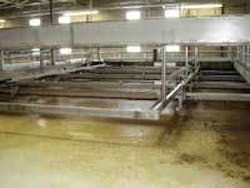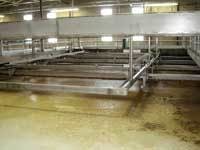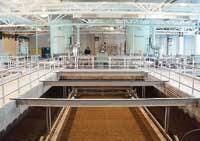Dissolved Air Flotation System Enhances Clarification Process
The Leopold Co. will be exhibiting its Clari-DAF (Dissolved Air Flotation) system at the American Water Works Association annual conference and exhibition. The system is typically used for clarification of water prior to filtration in drinking water processes.
In the Clari-Daf process, raw water particles are flocculated and separated out of the water by floating them to the surface rather than settling them to the bottom of a basin. The process introduces millions of micro-sized air bubbles through diffusers at the bottom of the basin where they mix with the coagulated solids and float particles that are as small as 10 microns in size.
The air bubbles are produced by recycling a portion of the clarified effluent through a pressurization tank where air is introduced and the water saturated, then reduced to ambient pressure at the nozzles in the reaction zone of the flotation tank, thus creating the pressurized flow. The floated sludge is removed from the top of the basin by mechanical or hydraulic means, while the clarified water is removed from the bottom of the basin through laterals.
The Clari-DAF system is particularly effective in removing low-density solids such as coagulated colloidal solids, algae, Giardia/Cryptosporidium, or precipitated color, organics, and metals. These are all contaminants that do not settle well without feeding additional chemicals and providing sufficient mixing to achieve a particle that is hundreds of microns in size.
With mechanical skimmers for solids removal, the system can produce 2% − 5% sludge solids, which reduces the sludge volume to handle and the cost of further processing whether by dewatering or hauling away the sludge solids.
Since it has the ability to remove contaminants that can potentially foul membranes, the Clari-DAF system is a suitable membrane pretreatment process. Removing the contaminants allows for an increased membrane flux rate thus reducing the number of modules required to treat a given flow. In addition, it reduces the backwashes and chemically enhanced backwashes, which, in turn, reduce membrane fatigue and increase the life of the membrane.
With the advent of the Backwash Water Treatment Rule, the system can be an effective process for separating the solids from the filter backwash, thickener overflow, or liquid from the dewatering process. The effluent can then be either recycled to the head of the plant or discharged to a stream while the solids are processed through the plant solids handling scheme.
An advantage of the Clari-DAF system is that it requires a smaller footprint than conventional settling clarification systems. In addition, CFD, or computational fluid dynamics modeling, and empirical studies have improved the hydraulic profile through the reaction and separation zone enabling more efficient use of tank volume.
The systems can have a loading rate up to 20 gpm/ft2, compared to conventional settling basin loading rates of 0.5 - 1.0 gpm/ft2.
The system also provides a viable option for clarification in the removal of low-density solids created by aluminum or iron hydroxides. As the requirements to remove contaminants from water supplies become more stringent, these low-density solids become a challenge that needs to be addressed without adversely affecting the downstream filter and dewatering process equipment.


